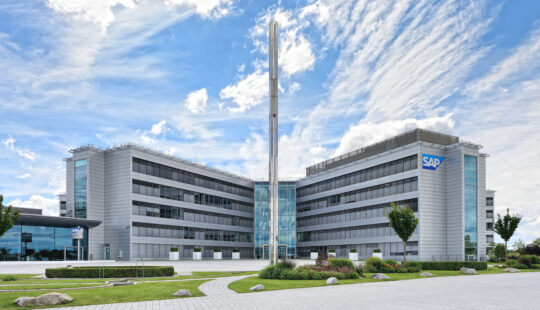SAP worked with the German government to develop an app that supports the country’s new KulturPass initiative, launched on June 14, which enables free access to culture and art for 18-year-olds.
Similar to programs that have already been rolled out in other European countries, the KulturPass cultural engagement program is an initiative by the German government for everyone who turns 18 in 2023 and lives in Germany. Each person who registers will receive €200 of credit to redeem through an SAP-developed app for a cultural experience of their choice, including concert, museum, movie, and theater tickets; books; records and CDs; musical instruments; and much more.
This collaboration between SAP and the German government serves as a compelling example of digitization within the public sector, showcasing the immense possibilities and paving the way for a substantial advancement in its digital transformation journey.
Germany Culture Minister Claudia Roth and Member of the Executive Board of SAP SE and Chief Technology Officer Juergen Mueller explain how the new culture pass for young people works and where the KulturPass app that SAP developed fits in.
Q: How does the KulturPass initiative work?
Claudia Roth: The KulturPass brings together young people and event organizers on a digital marketplace. Here, venues and other businesses can create their own store to advertise their events and activities. Young people who register for the scheme each receive a budget of €200, which they can use on the marketplace to buy tickets for concerts, plays, movies, and museums, for example. It is also possible to purchase books, comics, and musical instruments. They then receive a digital code that they redeem at the venue or shop, with the government reimbursing the vendor.
Could you tell us about the KulturPass app?
Juergen Mueller: The KulturPass app is the experience platform for the target audience participating in the KulturPass initiative. Users can check the app to see how much credit they have; search for events, activities, and products; buy tickets; and manage their purchases. It covers a broad range of local offerings to ensure that there is something for everyone.
Are there rules about how young people are allowed to spend this money?
Roth: They are pretty much free to choose how they spend their voucher. However, in light of some of the habits we adopted during the pandemic and our focus on local cultural venues, streaming services and large online retailers are excluded from the scheme. Also excluded, obviously, is anything that is anti-constitutional or inappropriate for young people. Otherwise, the KulturPass is open to all cultural outlets in Germany that are looking to attract a younger audience, from small bookstores through theaters, music festivals, record shops, concert venues, art galleries, memorials, arthouse movie theaters, to multiplex movie venues and independent theaters.
The German government is investing €100 million in the KulturPass. What do you hope its impact will be?
Roth: The KulturPass has two aims. The first is to rekindle interest in culture and the arts and give a much-needed financial boost to the culture industry, which is still suffering the after-effects of the pandemic. The second is to encourage young people to enjoy live culture in a way that they were unable to for two long years. We want to get them excited about the diversity and wealth of culture that Germany has to offer. And my hope is that, in turn, it will help teenagers discover how art and culture can enrich their lives.
Who are the partners on this project?
Roth: We’ve been working with three partners. The Digital Opportunities Foundation is responsible for the operational aspects of the scheme and for contact with the providers and users. The advertising agency Zum goldenen Hirschen has supported us on the communication side, and SAP developed the digital marketplace and app. I would like to take this opportunity to thank everyone at SAP who was involved in the project for their efficiency and dedication.
How did SAP’s technical expertise and experience help make the KulturPass project a success?
Mueller: When it comes to complex IT projects, SAP has vast experience and deep technical expertise that it can draw on. Our team of developers channeled their knowledge and skills into designing and implementing the KulturPass app. Following best practices, we used proven technologies and designs to produce an app that is reliable, secure, and easy to use. What’s more, we deployed our solutions alongside those of our partners to support the entire process end to end, from building the app through to managing users’ balances. All these factors have helped us contribute to making the KulturPass project a success – and to the ultimate aims of boosting the arts and culture sector and giving young people the chance to enjoy everything that it has to offer.
Apps like these are technically complex to build. What challenges did you face and how did you overcome them?
Mueller: First, I want to say what a fantastic job the team has done in designing, building, and implementing the KulturPass app. Doing all of that in just six months was a major achievement on the part of everyone involved. Delivering to such a tight schedule requires excellent teamwork and efficient project planning. We had to make sure that all the technical components integrate smoothly to give users a seamless experience. One of the biggest challenges was incorporating the various partner solutions, such as buyer and supplier management, into the overall architecture. We worked closely with our experts here at SAP and from our partners to overcome these challenges and deliver the KulturPass app on schedule.
How flexible is the KulturPass technical infrastructure? Can it adapt as the program evolves?
Mueller: If the program really takes off, the architecture behind the KulturPass app is flexible enough for us to adapt it quickly and add new functions as the program expands. Using SAP Business Technology Platform (SAP BTP) to develop the app means we can improve the app to reflect user feedback at any time. We’ll continue to tailor it to their needs to give teens in Germany the chance to experience everything that culture and the arts have to offer.
What is SAP doing to ensure that the KulturPass app is intuitive and accessible?
Mueller: When we designed the app, user experience was our top priority. At a very early stage, we consulted colleagues who have disabilities to obtain their feedback and advice on how to improve it. Our ambition was to go beyond meeting accessibility standards. We wanted to make the app as easy as possible to use by design, ensuring that it is clearly structured and intuitive, that it uses the language our intended users speak, that its colors have strong contrast, and that its compatible with screen-readers. Basically, we want the KulturPass app to be accessible and appealing to all young people. The app will therefore go through another round of rigorous usability tests over the next few weeks before additional accessibility features are delivered in the new release.
Data privacy and security are major concerns these days. How does the KulturPass app handle these aspects?
Mueller: We take data privacy and security very seriously at SAP. The app is built to the standards recommended by the German government, so it has stringent security mechanisms incorporated into it. As part of the development phase, we analyzed the kinds of cybersecurity threats that might occur and took steps to counter them. We also used penetration tests to simulate cyberattacks and test system security. These methods helped us identify vulnerabilities and mitigate risks. To ensure that only authorized people can use the app, we use electronic identification processes, such as the online function for the personal ID cards we all have here in Germany. We make sure, though, that the personal data of those using the app is secure and used only for the intended purpose.



